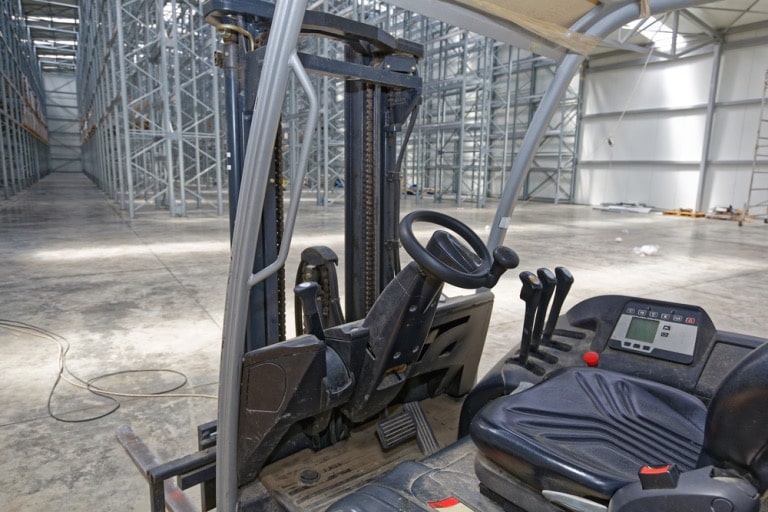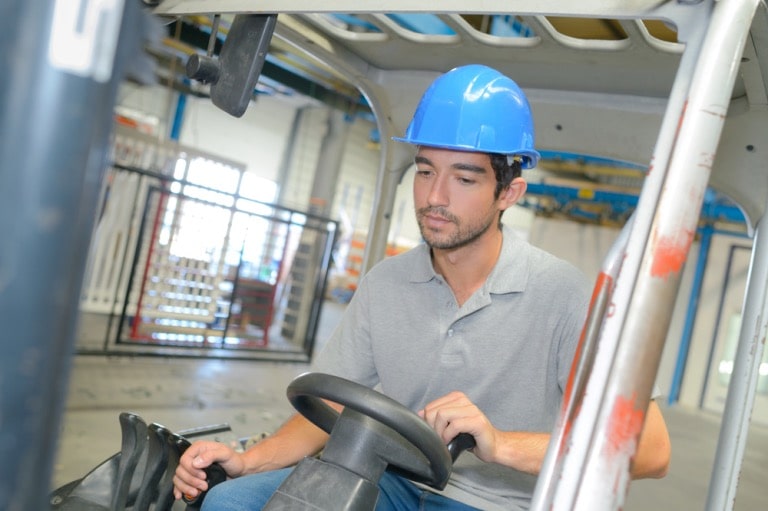At first glance, operating a forklift might seem like a challenge due to all the knobs, levers, pedals, and other forms of control that it has. However, forklift controls aren’t that complicated and you can learn to operate one in a few weeks!
Whether you’re curious about these controls or don’t know where to start, this article has got you covered!
Today, I’ll walk you through a brief guide with everything you need to know about forklift operation, including the components of forklift controls, a step by step guide to control one, and extra safety tips while operating one!
What Are the Components of Forklift Control?

In order to understand how forklifts work, you should get yourself familiar with all the components of forklift control, so let’s check them out:
1. Forklift Pedals
These are the simplest of all the controls of a forklift because they’re almost the same as normal vehicles.
The first pedal “usually on the right” is the accelerator pedal, which is responsible for moving and speeding up.
The other pedal is the brake pedal, which puts the forklift to a stop. It’s also used while altering the forklift’s directional controls to prevent the forklift from moving around.
Some forklifts, especially the advanced ones, will also have an extra clutch pedal that helps you switch gears on the forklift to increase its speed.
2. Forklift Directional Controls
These controls function similar to how you control a normal car’s transmission, although they’re built a little differently.
For example, if you want to make a forklift move forward, you switch it to the forward mode. If you want the forklift to go backward, you switch it to reverse mode.
There’s also a neutral position where the forklift isn’t hooked on any gears. These controls are usually through a shifter or operated by foot.
3. Hydraulic Lift Knobs
The hydraulic lift knobs are the ones responsible for controlling the hydraulic lift’s movements. Ideally, a forklift will have several knobs that allow the forklift to move in the following directions:
- Going up and down
- Tilting the forks forwards or backward
- Moving the lift to the right or the lift
- Adjusting the distance between the forks, but it’s found in specific models of forklifts
4. Inching Pedal
Since the forklift is responsible for transferring objects through warehouses with narrow aisles and corridors, the inching pedal is extremely essential for its operation.
This one allows the operator to make little movements at a time in order to creep the loads and maneuver them at slow speeds. The pedal is usually found on the left-hand side of the steering column.
5. Parking Brake
The parking brake works exactly like the one found in regular vehicles and its job is to put the forklift to a complete stop.
While some forklifts have a specific brake to hold them in place, some types of forklifts will have an automatic parking brake that is activated once you release the acceleration pedal.
How to Control the Forklift Safely

Here’s a quick step by step guide that walks you through the process of controlling a forklift:
- Put on safety gear to ensure your safety.
- Give the forklift a quick check, and make sure that it’s properly charged or refueled, then hop onto the operator’s seat and buckle on your seatbelts.
- Start the forklift engine by turning its key while pressing on the brakes.
- Lift the forklift blades a few inches above the ground using the levers to prevent ground scraping.
- Move towards the object you want to lift using the acceleration pedal and use the inching pedal to carefully approach and maneuver the forklift around the tight corners. (use the shifter and clutch if necessary)
- Stop when your forklift blades are about 1 foot away from the object you want to lift and adjust the height of the forklift blades to match the item’s height.
- Ensure that the weight of the item is lower than the maximum lifting capacity of the forklift.
- Center the blades of the forklift to be exactly in the middle while putting the center of gravity of the item in mind (some sides might be equal in size but vary in weight). You can also adjust the width of the blades to handle larger items easily.
- Lift the item a few inches above the ground and make sure that the load is stable by moving carefully in various directions.
- Use the hydraulic lift knobs to tilt the item a few degrees towards the forklift for extra safety.
- Move towards the unloading destinations with your pedals and directional controls.
- Return the blades to a neutral untitled position.
- Lower the forklift blades so that the items are safely on the ground.
- Back up slowly until the forklift’s blades are far from the item.
- Take the forklift to the area where you’re supposed to park it
- Press the brake pedal with your foot to keep the forklift in place, and engage the parking brake without releasing the brake pedal until the parking brake is completely engaged.
- Turn off the forklift using the keys.
Important Safety Tips While Operating a Forklift
Now that you know how to operate a forklift, there are some essential safety tips that you should always keep in mind in order to avoid accidents while controlling a forklift. Let’s have a quick look at them:
- Find a certified professional to teach you how to operate a forklift properly and in a safe location
- Give the forklift an all-around check before operating it and make sure that it operates properly. You should also make sure that it has enough power to get the job done
- Always wear proper safety gear when you’re near a forklift and treat it like any other heavy machinery
- Make sure that you balance the load on both blades of the forklift to distribute the weight and prevent the item from tipping off
- Check the lifting capacity of the forklift and avoid exceeding it to help the hydraulic lift service for as long as possible
Final Thoughts
This wraps it up for today’s guide about forklift controls and what you need to know before learning how to operate one.
As you can see, operating forklifts have a learning curve to it, but once you pass a certain point, it becomes second nature to you, so make sure that you practice in a suitable environment and follow the safety tips provided above!